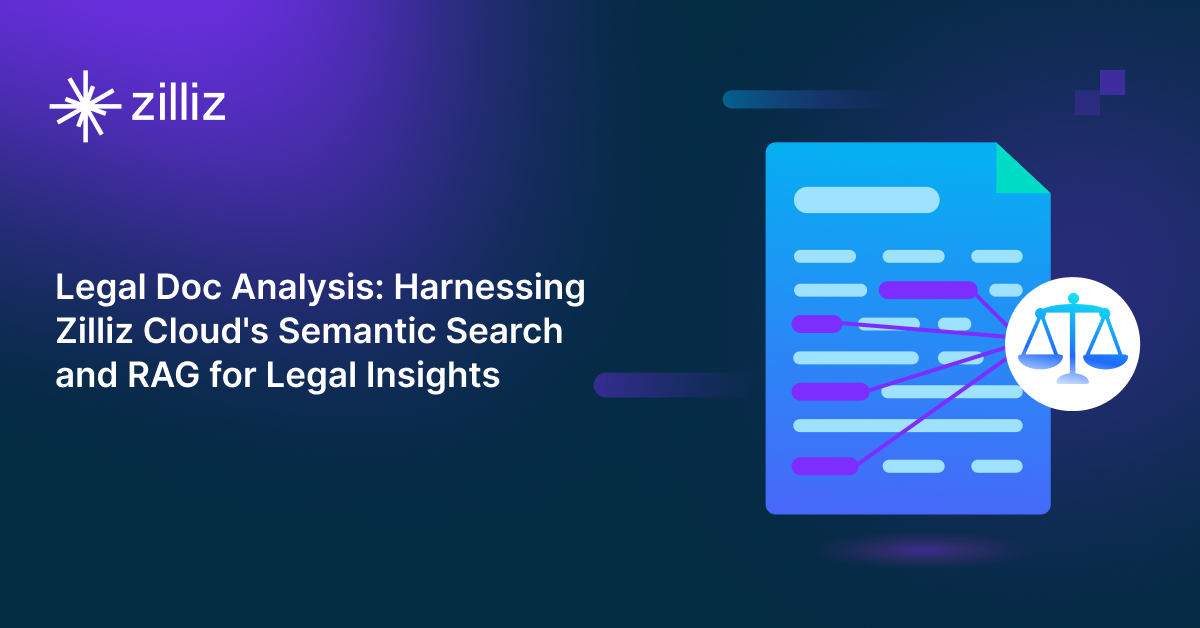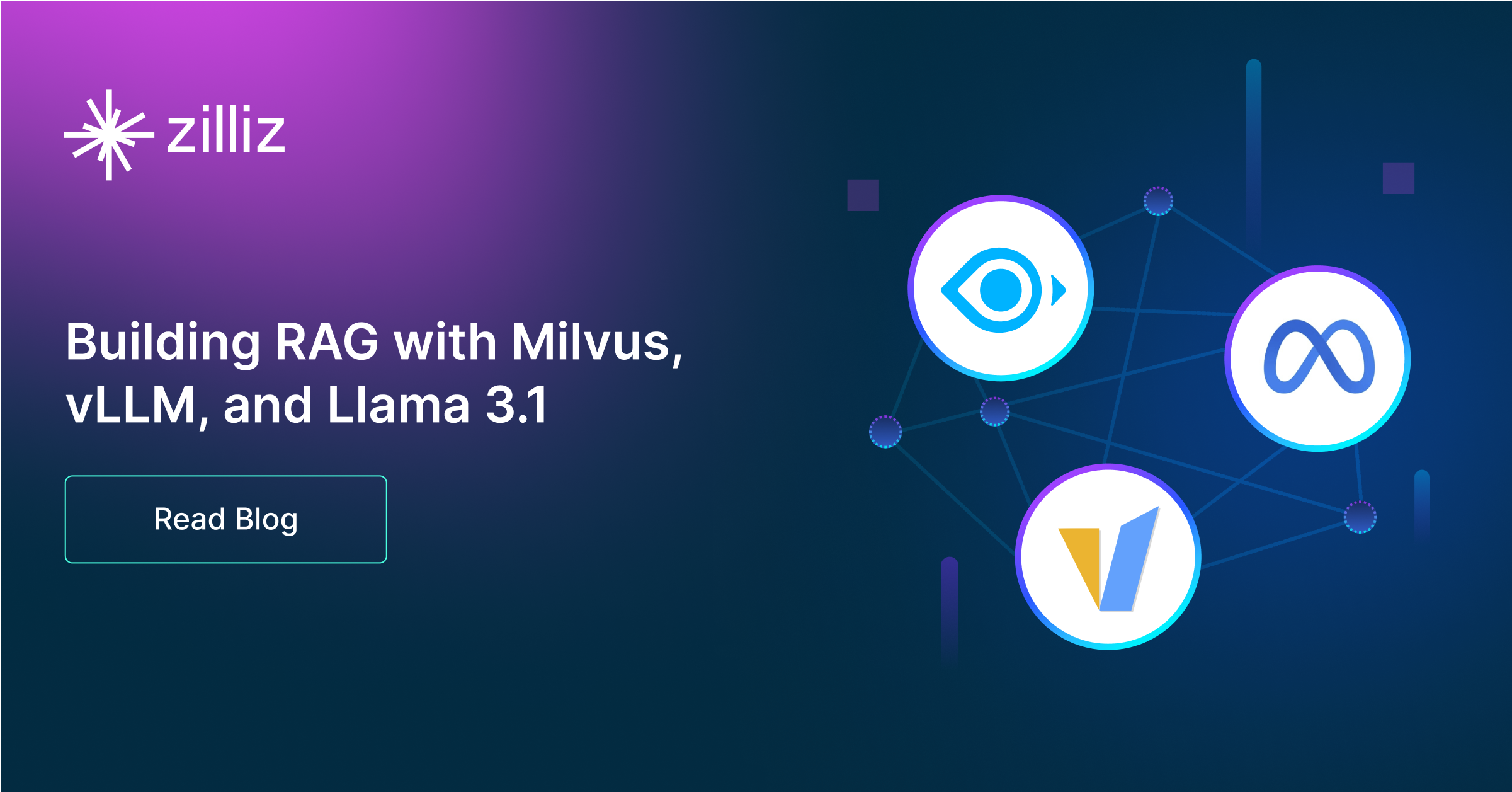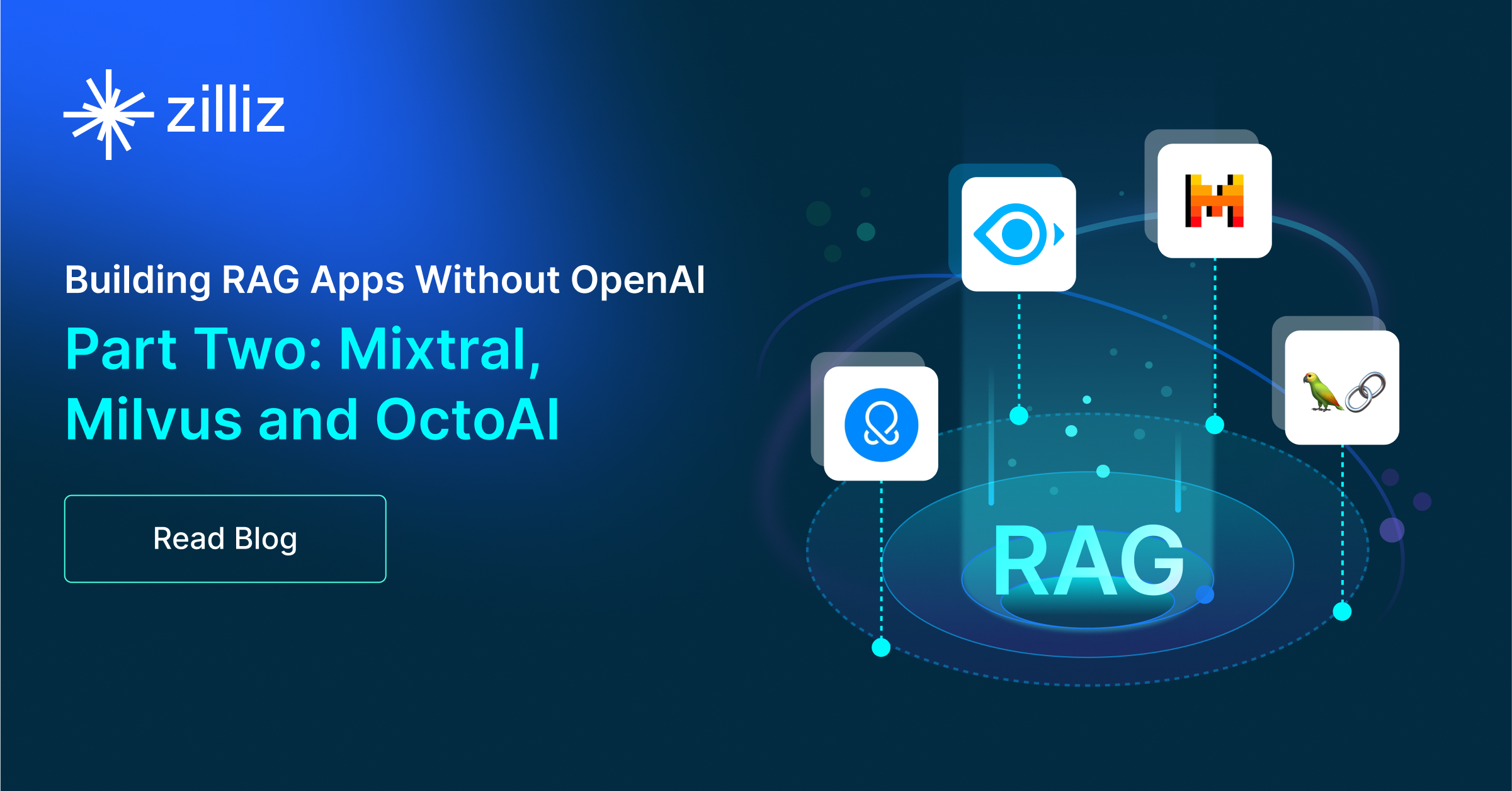Build RAG Chatbot with LangChain, OpenSearch, Cohere Command R, and Cohere embed-english-light-v2.0
Introduction to RAG
Retrieval-Augmented Generation (RAG) is a game-changer for GenAI applications, especially in conversational AI. It combines the power of pre-trained large language models (LLMs) like OpenAI’s GPT with external knowledge sources stored in vector databases such as Milvus and Zilliz Cloud, allowing for more accurate, contextually relevant, and up-to-date response generation. A RAG pipeline usually consists of four basic components: a vector database, an embedding model, an LLM, and a framework.
Key Components We'll Use for This RAG Chatbot
This tutorial shows you how to build a simple RAG chatbot in Python using the following components:
- LangChain: An open-source framework that helps you orchestrate the interaction between LLMs, vector stores, embedding models, etc, making it easier to integrate a RAG pipeline.
- OpenSearch: An open-source search and analytics suite derived from Elasticsearch. It offers robust full-text search and real-time analytics, with vector search available as an add-on for similarity-based queries, extending its capabilities to handle high-dimensional data. Since it is just a vector search add-on rather than a purpose-built vector database, it lacks scalability and availability and many other advanced features required by enterprise-level applications. Therefore, if you prefer a much more scalable solution or hate to manage your own infrastructure, we recommend using Zilliz Cloud, which is a fully managed vector database service built on the open-source Milvus and offers a free tier supporting up to 1 million vectors.)
- Cohere Command R: This model is designed for high-performance retrieval tasks, offering advanced capabilities in understanding and generating natural language. Its strengths lie in semantic search and document summarization, making it ideal for applications such as customer support, content generation, and knowledge management, where accuracy and context relevance are paramount.
- Cohere embed-english-light-v2.0: This lightweight embedding model is designed for efficient English text encoding, providing high-quality representations for various natural language processing tasks. It excels in scenarios requiring embedding generation with minimal computational resources, such as document similarity, clustering, and recommendation systems, ensuring fast performance without compromising accuracy.
By the end of this tutorial, you’ll have a functional chatbot capable of answering questions based on a custom knowledge base.
Note: Since we may use proprietary models in our tutorials, make sure you have the required API key beforehand.
Step 1: Install and Set Up LangChain
%pip install --quiet --upgrade langchain-text-splitters langchain-community langgraph
Step 2: Install and Set Up Cohere Command R
pip install -qU "langchain[cohere]"
import getpass
import os
if not os.environ.get("COHERE_API_KEY"):
os.environ["COHERE_API_KEY"] = getpass.getpass("Enter API key for Cohere: ")
from langchain.chat_models import init_chat_model
llm = init_chat_model("command-r", model_provider="cohere")
Step 3: Install and Set Up Cohere embed-english-light-v2.0
pip install -qU langchain-cohere
import getpass
import os
if not os.environ.get("COHERE_API_KEY"):
os.environ["COHERE_API_KEY"] = getpass.getpass("Enter API key for Cohere: ")
from langchain_cohere import CohereEmbeddings
embeddings = CohereEmbeddings(model="embed-english-light-v2.0")
Step 4: Install and Set Up OpenSearch
pip install --upgrade --quiet opensearch-py langchain-community
from langchain_community.vectorstores import OpenSearchVectorSearch
opensearch_vector_search = OpenSearchVectorSearch(
"http://localhost:9200",
"embeddings",
embedding_function
)
Step 5: Build a RAG Chatbot
Now that you’ve set up all components, let’s start to build a simple chatbot. We’ll use the Milvus introduction doc as a private knowledge base. You can replace it with your own dataset to customize your RAG chatbot.
import bs4
from langchain import hub
from langchain_community.document_loaders import WebBaseLoader
from langchain_core.documents import Document
from langchain_text_splitters import RecursiveCharacterTextSplitter
from langgraph.graph import START, StateGraph
from typing_extensions import List, TypedDict
# Load and chunk contents of the blog
loader = WebBaseLoader(
web_paths=("https://milvus.io/docs/overview.md",),
bs_kwargs=dict(
parse_only=bs4.SoupStrainer(
class_=("doc-style doc-post-content")
)
),
)
docs = loader.load()
text_splitter = RecursiveCharacterTextSplitter(chunk_size=1000, chunk_overlap=200)
all_splits = text_splitter.split_documents(docs)
# Index chunks
_ = vector_store.add_documents(documents=all_splits)
# Define prompt for question-answering
prompt = hub.pull("rlm/rag-prompt")
# Define state for application
class State(TypedDict):
question: str
context: List[Document]
answer: str
# Define application steps
def retrieve(state: State):
retrieved_docs = vector_store.similarity_search(state["question"])
return {"context": retrieved_docs}
def generate(state: State):
docs_content = "\n\n".join(doc.page_content for doc in state["context"])
messages = prompt.invoke({"question": state["question"], "context": docs_content})
response = llm.invoke(messages)
return {"answer": response.content}
# Compile application and test
graph_builder = StateGraph(State).add_sequence([retrieve, generate])
graph_builder.add_edge(START, "retrieve")
graph = graph_builder.compile()
Test the Chatbot
Yeah! You've built your own chatbot. Let's ask the chatbot a question.
response = graph.invoke({"question": "What data types does Milvus support?"})
print(response["answer"])
Example Output
Milvus supports various data types including sparse vectors, binary vectors, JSON, and arrays. Additionally, it handles common numerical and character types, making it versatile for different data modeling needs. This allows users to manage unstructured or multi-modal data efficiently.
Optimization Tips
As you build your RAG system, optimization is key to ensuring peak performance and efficiency. While setting up the components is an essential first step, fine-tuning each one will help you create a solution that works even better and scales seamlessly. In this section, we’ll share some practical tips for optimizing all these components, giving you the edge to build smarter, faster, and more responsive RAG applications.
LangChain optimization tips
To optimize LangChain, focus on minimizing redundant operations in your workflow by structuring your chains and agents efficiently. Use caching to avoid repeated computations, speeding up your system, and experiment with modular design to ensure that components like models or databases can be easily swapped out. This will provide both flexibility and efficiency, allowing you to quickly scale your system without unnecessary delays or complications.
OpenSearch optimization tips
To optimize OpenSearch in a Retrieval-Augmented Generation (RAG) setup, fine-tune indexing by enabling efficient mappings and reducing unnecessary stored fields. Use HNSW for vector search to speed up similarity queries while balancing recall and latency with appropriate ef_search and ef_construction values. Leverage shard and replica settings to distribute load effectively, and enable caching for frequent queries. Optimize text-based retrieval with BM25 tuning and custom analyzers for better relevance. Regularly monitor cluster health, index size, and query performance using OpenSearch Dashboards and adjust configurations accordingly.
Cohere Command R optimization tips
Cohere Command R is designed for retrieval-augmented generation, making efficient context retrieval and ranking critical for system performance. Optimize retrieval pipelines by using Cohere’s embedding-based search to identify and rank the most relevant documents, reducing unnecessary input context while maintaining accuracy. Improve response quality by fine-tuning temperature settings; lower values (0.1–0.2) work best for structured, fact-based queries, while higher values introduce more variability in generated responses. Utilize prompt templates to maintain consistent formatting, ensuring clarity in output. Implement batch processing where multiple queries need similar context, reducing redundant API calls. To enhance efficiency, cache top query results and leverage incremental context updates instead of repeatedly sending full document sets. If deploying at scale, monitor latency and response consistency with real-time metrics, adjusting retrieval thresholds dynamically for optimal balance between speed and completeness.
Cohere embed-english-light-v2.0 optimization tips
Cohere embed-english-light-v2.0 is designed for faster, more resource-efficient embedding generation in English-language tasks. To optimize processing, preprocess text by removing stopwords, punctuation, and unnecessary formatting to minimize the complexity of the input. Leverage vector compression techniques, such as quantization or PCA, to reduce storage requirements without sacrificing significant accuracy. For retrieval, implement hybrid search strategies that combine keyword search with dense vector search to achieve faster and more relevant results. Use multi-threading or parallel processing to handle large batches of embeddings efficiently. Apply caching for frequently queried embeddings to minimize re-processing and reduce query latency, especially for high-traffic RAG systems.
By implementing these tips across your components, you'll be able to enhance the performance and functionality of your RAG system, ensuring it’s optimized for both speed and accuracy. Keep testing, iterating, and refining your setup to stay ahead in the ever-evolving world of AI development.
RAG Cost Calculator: A Free Tool to Calculate Your Cost in Seconds
Estimating the cost of a Retrieval-Augmented Generation (RAG) pipeline involves analyzing expenses across vector storage, compute resources, and API usage. Key cost drivers include vector database queries, embedding generation, and LLM inference.
RAG Cost Calculator is a free tool that quickly estimates the cost of building a RAG pipeline, including chunking, embedding, vector storage/search, and LLM generation. It also helps you identify cost-saving opportunities and achieve up to 10x cost reduction on vector databases with the serverless option.
 Calculate your RAG cost
Calculate your RAG cost
What Have You Learned?
By diving into this tutorial, you’ve unlocked the power of combining cutting-edge tools to build a fully functional RAG system from the ground up! You learned how LangChain acts as the glue, seamlessly orchestrating workflows between components. OpenSearch, your vector database powerhouse, efficiently stores and retrieves embeddings generated by Cohere’s lightweight yet robust embed-english-light-v2.0 model, turning unstructured text into searchable knowledge. Then, Cohere’s Command R steps in as the brains of the operation, synthesizing retrieved context into human-like responses that feel natural and insightful. Together, these tools form a dynamic pipeline where data flows from storage to understanding to action—all while you maintain control over accuracy, speed, and relevance. Along the way, you discovered practical optimizations, like tuning chunk sizes for embeddings or adjusting retrieval thresholds, to balance performance and cost without sacrificing quality. And let’s not forget that handy free RAG cost calculator you explored—your secret weapon for budgeting and scaling projects responsibly!
But this isn’t just about following steps—it’s about empowerment. You now have the toolkit to transform static data into intelligent, responsive applications. Whether you’re building a chatbot, a research assistant, or a custom knowledge hub, the principles you’ve mastered here are your launchpad. Experiment with different prompts in LangChain, tweak OpenSearch’s indexing strategies, or swap in other Cohere models to see how responses evolve. The possibilities are endless, and the best part? You’re already equipped to innovate. So fire up your IDE, embrace the trial-and-error magic of building, and let your creativity run wild. The future of AI-driven applications is yours to shape—one RAG pipeline at a time. Let’s go build something amazing! 🚀
Further Resources
🌟 In addition to this RAG tutorial, unleash your full potential with these incredible resources to level up your RAG skills.
- How to Build a Multimodal RAG | Documentation
- How to Enhance the Performance of Your RAG Pipeline
- Graph RAG with Milvus | Documentation
- How to Evaluate RAG Applications - Zilliz Learn
- Generative AI Resource Hub | Zilliz
We'd Love to Hear What You Think!
We’d love to hear your thoughts! 🌟 Leave your questions or comments below or join our vibrant Milvus Discord community to share your experiences, ask questions, or connect with thousands of AI enthusiasts. Your journey matters to us!
If you like this tutorial, show your support by giving our Milvus GitHub repo a star ⭐—it means the world to us and inspires us to keep creating! 💖
- Introduction to RAG
- Key Components We'll Use for This RAG Chatbot
- Step 1: Install and Set Up LangChain
- Step 2: Install and Set Up Cohere Command R
- Step 3: Install and Set Up Cohere embed-english-light-v2.0
- Step 4: Install and Set Up OpenSearch
- Step 5: Build a RAG Chatbot
- Optimization Tips
- RAG Cost Calculator: A Free Tool to Calculate Your Cost in Seconds
- What Have You Learned?
- Further Resources
- We'd Love to Hear What You Think!
Content
Vector Database at Scale
Zilliz Cloud is a fully-managed vector database built for scale, perfect for your RAG apps.
Try Zilliz Cloud for Free


